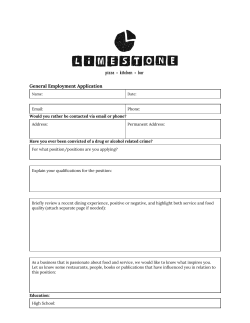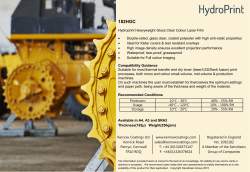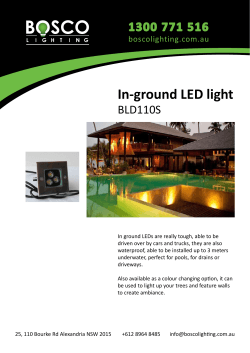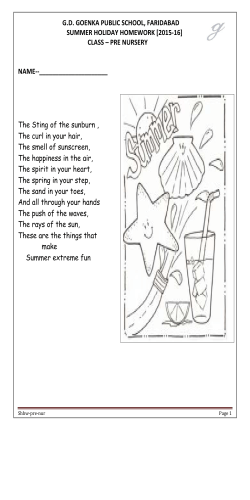
Capricorn Yanchep | Property for Sale Yanchep WA
Capricorn Beach Design Guidelines May 2013 Design Guidelines CONTENTS Vision for Capricorn Yanchep…………………………………………….…………………………………………………………………………………………………… 1 Capricorn Coastal Character………………………………………………………………………………………………………………………………………………………… 1 Benefits of the Design Guidelines…………………………………………………………………………………………………………………………………….……………1 Lot Characteristics, Detailed Area Plans & Special Sites…………………………………………………………………………………………….………… 2 The Characteristics of Cottage Lots……………………………………………………………………………………………………………………………………………… 3 Detailed Area Plan or Capricorn Development Plan Applicable to Cottage Lots GENERIC SAMPLE ONLY………………………………….…………. 4 The Characteristics of Traditional Lots…………………………………………………………………………………………………………………………………………. 5 The Characteristics of Dune Lots…………………………………………………………………………………………………………………………………………………. 6 Detailed Area Plan Applicable to Dune Lots GENERIC SAMPLE ONLY……………………………………………………………………………………………….7 Details of the Capricorn Design Guidelines…………………………………………………..………………………………………………………………………. 8 The 4 architectural elements – Materials and Configuration…………………………………………………………………………………………………………… 8 - Walls……………………………………………………………………………………………………………………………………………………………………………………… 9 - Roof…………………………………………………………………………………………………………………………………………………………………………………….. 12 - Openings……………………………………………………………………………………………………………………………………………………………………………… 13 - Attachments…………………………………………………………………………………………………………………………………………………………………………. 14 Landscape Materials…………………………………………………………………………………………………………………………………………………………………. 15 Sustainability Elements…………………………………………………………………………………………………………………………………………………………….. 16 Building Approval & Statutory Approval Process..................................................................................................................... 18 Vision for Capricorn Yanchep Capricorn Coastal Character The inspiration for the vision for Capricorn comes from the natural coastal landscape and character of well loved places along WA’s coastline, such as Fremantle and Rottnest. These places have an overall appearance that is distinctly coastal and relaxed – there is a ‘lightness’ to the buildings which comes from the simplicity of their architectural form and a simple yet striking palette of materials, reflecting soft seaside tones and natural coastal materials, such as limestone and timber. The intent of these design guidelines is to create a similar feel for the Capricorn development. It is envisaged that Capricorn will become a seaside village with a distinct identity that sets it apart from the regular suburbs to the south and east – it will be a place where its residents feel like they are always on holidays. The design guidelines provide individual residents with guidance on building a home that adds to this special character and spirit of Capricorn. The Benefits of the Design Guidelines • Confidence in knowing the coastal character of building on your lot and on neighbouring lots. • Protection of a personal and community investment. • Certainty of a base line design quality for development. . • Creation of a memorable and harmonious coastal place. • Balance of community and private interests – a common vision. 1 Design Guidelines Lot Characteristics, Detailed Area Plans & Special Sites 1. The Design Guidelines encourage innovation within the parameters of the Capricorn character. Guidance is provided on Urban Design - Architecture - Landscape - Sustainability. 2. There are building character conditions for ‘special sites’ (specific lots on key streets and around public parks), and Capricorn Development Plans or Detailed Areas Plans that define planning requirements on all Cottage and Dune lots and some Traditional lots (always refer to your purchase contract to check the status and requirements for your lot). 3. The Town Architect upholds the vision for Capricorn through advice and guidance. 2 Design Guidelines The Characteristics of Cottage Lots • Typically 10m to 14m lot frontages with front or rear access – zoned R30 (site coverage generally 70%, check your sales contract ) • Publicly visible elevation shall address the front street. A house on a corner lot shall address the front and a portion of the side street by including openings such as windows and the same quality and style of design on both publicly visible elevations. • Garage is accessible from a rear lane or side street and in some cases from the front. If the lot is front loaded (garage at front) the garage must be setback behind the front elevation by 0.5 metres. For a two storey house the garage may be forward of the house provided a room is over the garage. • Single or double-storey home permitted. • Over hanging eaves are encouraged. • A front feature element shall be incorporated such as a verandah, porch, portico, gable or gablet. • Detailed Area Plans or Capricorn Development Plans (refer to sales contract) define planning setbacks, garage and private yard locations. • For lots identified as ‘special sites’ – a 2.4m minimum deep veranda that is 50% min. length of front elevation (4m min.) is mandatory. • Roof eaves height of 2.4m (28c) minimum above finished floor level (FFL) - mandatory for front elevation and a proportion of the secondary street on a corner lot (ie. length of front room). Garages may be at 2.1m (25c). • Landscaping – Front yard landscaping provided by the developer will be cottage style gardens featuring native and other drought resistant species consistent with the coastal character of the area with a limited amount of turf. 3 Design Guidelines Detailed Area Plan or Capricorn Development Plan Applicable to Cottage Lots GENERIC SAMPLE ONLY Provisions The provisions of this Detailed Area Plan (DAP) should be read in conjunction with the requirements of the Residential Design Codes (R-Codes). The requirements of the R-Codes and District Planning Scheme must be satisfied in all other matters to the satisfaction of the City of Wanneroo. Garaging and Access 1. Garages shall be located as depicted on this DAP. 2. Where a preferred garage location is depicted, an alternative location may be approved by the City of Wanneroo. 3. Vehicular access to lots shall not be permitted from street frontages identified with ‘no vehicular access’. Setbacks 1. The front setback of the dwelling shall be a minimum of 3m and a maximum of 4.5m. 2. The rear setback of lots with rear laneway access shall be a maximum of 1.5m. Reduced setbacks may be approved subject to appropriate access levels and vehicle sight lines. 3. In addition to the provisions of Clause 3.3.2 of the R-Codes the following shall apply: - one zero lot wall is mandatory for lots less than 12m in width, - where a zero lot wall is either discretionary, or required, it shall be located as depicted on the attached plan. Built Form 1. The outdoor living areas of lots orientated east – west, as specified in Clause 3.4.2 of the R-Codes, shall be located on the northern side. Typical House Layout 4 Design Guidelines The Characteristics of Traditional Lots • Up to 20m wide lot frontage with front garage location – zoned R25 (site coverage generally 60%,check your sales contract) • Publicly visible elevation shall address the front street. A house on a corner lot shall address the front and a portion of the side street by including openings such as windows. • Garage is setback behind the front elevation by a minimum of 0.5 metres. For a 2-storey house, the garage may be forward of the house provided a room is over the garage. This is to minimise the dominance of garages to the street and improve streetscape aesthetics. • Single or double-storey home permitted. • Overhanging eaves are mandatory (except for garages and non habital rooms which are not on the front elevation). • A front feature element shall be incorporated such as a verandah, porch, portico, gable or gablet. • Some specific Lots include Detailed Area Plans or Capricorn Development Plans (refer to sales contract) define building setbacks, garage and private yard locations • For lots identified as ‘special sites’ – a 2.4m minimum deep veranda that is 50% min. length of front elevation (4m min.) is mandatory. • Roof eaves height of 2.4m (28c) minimum above finished floor level (FFL) mandatory for front elevation and a proportion of the secondary street on a corner lot (ie. length of front room). Garages may be at 2.1m (25c). • Landscape - A combination of native vegetation and drought resistant vegetation, suitable hardscape materials and lawn will be installed between the street and the front of the house. 5 Design Guidelines The Characteristics of Dune Lots • 1000 - 2000sqm area – Zoned R5 or R10. • Detailed Area Plans if applicable (define access and the building envelope within existing and retained vegetation). • Freestanding house, with high quality elevations visible from all sides and mandatory overhanging eaves. • Garage is setback behind the front elevation by a minimum of 0.5 metres. For a 2- storey house, the garage may be forward of the house provided a room is over the garage. This is to minimise the dominance of garages to the street and improve streetscape aesthetics. Garages forward of the home will be considered, where designs seek to take advantage of the land topography. • Use of lightweight materials encouraged (such as timber and pole construction on slopes). • Outbuildings permitted. • Natural weathering materials to be used for fences around the building envelope i.e. no Hardiefence (super-six) or Colorbond. • For lots identified as ‘special sites’ – a 2.4m minimum deep veranda that is 50% min. length of front elevation (4m min.) is mandatory. • Developer will provide boundary fencing. • Roof eaves height of 2.4m (28c) minimum above finished floor level (FFL) - mandatory for front elevation and a proportion of the secondary street on a corner lot (ie. length of front room). Garages may be at 2.1m (25c). • Landscape – The development envelope guarantees retention of the existing coastal vegetation to a significant extent adjacent to all lot boundaries. Naturalistically clustered Australian shrubs and trees may be planted in organic forms to enhance the natural environment. Hard landscape features should be drawn from the natural environment. For example, rubble limestone walls, crushed limestone driveways and sand paths are encouraged. Roads and pathways should only have low profile edging and preferably no edging at all. No cut and fill of more than one metre in total is allowed across the lot. Limestone walls should be used to retain these edges. Defined edges should also be established between the built and natural environment using low walls or retained edges. The lots are to be lawn free unless in clearly defined areas within the development envelope. 6 Design Guidelines Sample of a Detailed Area Plan Applicable to Dune Lots GENERIC SAMPLE ONLY Provisions The provisions of this Detailed Area Plan (DAP) should be read in conjunction with the requirements of the Residential Design Codes (RCodes). The requirements of the R-Codes and District Planning Scheme must be satisfied in all other matters to the satisfaction of the City of Wanneroo. Access 1. Vehicular access to lots shall not be permitted from street frontages identified with ‘no vehicular access’. 2. Vehicular drive ways shall be constructed to a maximum width of 4m. Detailed Area Plan - sample only Vegetation 1. Native vegetation is only permitted to be cleared outside the designated envelope for the construction of a vehicular driveway and firebreaks where required. Built Form / Development 1. All built form and manicured gardens shall be contained within the specified envelope (including paving, sheds, and swimming pools). 2. The total area of land to be developed (ie. all built form and private open space) shall not exceed 650sqm of the designated envelope area. 3. The 650sqm developable area can be located in one or a combination of smaller areas within the designated envelope area. 4. The remainder of the designated envelope area shall be retained and maintained as native vegetation. 5. All boundary fencing must be constructed and maintained as post and wire fencing. 6. Outbuildings (sheds, garages, etc.) of greater than 20sqm in size shall be constructed in the same material and colour as the main dwelling. Outbuildings of less than 20sqm may be constructed of materials compatible to the house. Typical Layout 7 Design Guidelines Details of the Capricorn Design Guidelines • The Design Guidelines advise requirements on the Capricorn coastal character. • A broad variety of high quality design options are possible. • Any variations to the Design Guidelines will require justification. Consideration will be given to high quality and innovative design if reflective of the Capricorn coastal character. • The Developer will continue to liaise with lot owners and home builders to evolve the Design Guidelines as the Capricorn coastal character develops. The 4 Architectural Elements – Materials & Configuration In simple terms each home will comprise 4 main components. 1. Walls 2. Roof 3. Openings 4. Attachments 8 Design Guidelines Walls – Material and Colour Front Elevation Front elevation and proportion of visible side elevation on corner lots: • Painted cement render as per colour palette or equivalent. • Feature elements can be comprised of materials such as bagged render, stone cladding, feature brick, weatherboards, rammed earth or other materials approved by the Seller which is in keeping with the Capricorn Village coastal theme. • Colorbond metal roof colours may also be selected as wall render colours (page 12). EARTHY OCHRE BALSAWOOD Side and Rear Elevation • Painted cement render as per colour palette or equivalent. • Face brick may be selected from the palette below: Midland Brick 2c Augusta Limestone, Centenary Limestone, Florentine Limestone & Whitecliffe. 1c Cream Mexi, Cream Smooth, Limestone Hue, Milano, & Seville. Austral 2c Albany Cream, Federation Limestone, Geographe Limestone & Prevelly. 1c Cervantes, Collie, Hamelin , Rustic & Telfer. Capricorn Colour Palette: Colour names are as per the Solver range – equivalent colours are acceptable subject to approval. Brikmakers 2c Bremer Bay, Coquina Limestone, Looganna Limestone, Mandu, Trealla Limestone & Tivoli. 1c Alkimos, Caraban Cream, Classic Cream, Classic Cream Tumbled, Toolonga & Tamala. 9 Design Guidelines Walls – Materials & Colour Corrugated Metal Sheets (including mini-orb) Zincalume or as per colour palette or similar. Featurestone Natural or as per colour palette or similar. Weatherboards and Cladding • • • • • Hardies Linea or Newport weatherboards (or similar alternative). Hardies Scyon Hardies Matrix Hardies HardiFlex sheets (or similar alternative). Painted as per colour palette (or similar) or offwhite. Letterboxes If letterboxes are freestanding they must be constructed in rendered and painted masonry to match the front external wall finish of the home. HARDIES HARDIFLEX SHEETS 10 Design Guidelines Walls – Use of Materials & Colours • Change of material along horizontal lines, with lighter materials above heavier. • Change of material along vertical lines between main and feature structures. Column Supporting a Floor Slab or Main Roof or Heavy Structure • Column finish same as the wall, rectangular in form and minimum 350mm square; or • Natural or off-white painted timber or metal as Guidelines palette (page 12). Rectangular in form, minimum 90mm square. Posts equally spaced apart. Post Supporting a Secondary Roof or a Lightweight Structure • Natural or off-white painted timber or metal as Guidelines palette (page 12). Rectangular in form, minimum 90mm square. Posts equally spaced apart. • No arches, precast columns and balustrades, mock historical styles and reproductive features, ornate and overly decorative features (un-coastal). 11 Materials & Colours Design Guidelines Roof Zincalume or Colorbond metal roof as per metal colour palette. Metal Colour Palette Main Roof • A range of roof pitches from 25 to 35 degrees. . • Simple hipped roof. • Roof eaves height of 2.4m (28c) minimum above finished floor level (FFL) - mandatory for front elevation and a proportion of the secondary street on a corner lot (ie. length of front room). Garages may be at 2.1m (25c). Surfmist Dune • Overhanging eaves mandatory for houses on Traditional (see page 5 for exemptions) and Dune Lots. • Alternative design solutions to the solar protection of openings, particularly on any publicly visible western elevation, are subject to the approval of the Developer. Shale Grey Evening Haze • Lightweight low pitched skillion, flat and low curvature arched roofs are permitted. • To assist in articulating the public visible elevations a front feature element or combination of elements such as gable or porch, verandah etc. shall be incorporated. • Roof penetrations, including vent pipes, are not permitted on front elevation or publicly visible areas. Zincalume Windspray Quarter round gutter encouraged (Ovulo is acceptable) to match roof colour Secondary Roof (i.e. attached roof or verandah) • Lean-to (min. 5 degrees pitch) or flat – i.e. less than 5 degrees and screened by a parapet wall). Roof pitch Overhanging eaves mandatory for houses on Traditional and Dune Lots between 25 and 35 degrees 2.4m verandah mandatory on “special lots” (eaves may be flush) Eaves are 2.4m min (28c) above finished floor level Extended eaves of 1m minimum depth are permitted at a height less than 2.4m above FFL Fascia to match roof or off-white Eaves linings, trims and any exposed rafters painted off-white Round downpipes encouraged, to match gutter or wall colour Roof penetrations (i.e. vents, air conditioner) to match or be similar to roof colour 12 Design Guidelines Openings Windows • Natural timber or off-white painted timber; or powder coated aluminium as metal colour palette, off white or similar; or unpainted galvanised steel. • Windows must be square or vertically proportioned (height greater than width and no arch) with horizontal proportions used in lightweight materials acceptable. Front Door Natural timber or off-white painted timber or aluminium as per colour palette (no stained glass). Garage Door • Natural timber / timber look or off-white painted timber or aluminium as per metal colour palette. • One material only and no glass panes. • Carport permitted – must include a door and be screened on publicly visible sides. Shutters • Natural timber or off-white painted timber, powder coated aluminium as per metal colour palette or unpainted galvanised steel. • Louvered, sized and shaped to match opening. Flyscreen Colour matched and integrated in window system. Security Screen • To match door colour behind. • Use of detention mesh is encouraged. Glass No reflective mirror glass (standard tinted glass permitted). 13 Design Guidelines Attachments Verandah • Zincalume or Colorbond corrugated metal roof as per metal colour palette. • Mandatory for ‘Special Sites’ only - 2.4m minimum deep and minimum 50% length of front elevation (4m minimum). • A verandah roof (1m minimum width) may be at a lower height to the 2.4m min. required FFL eaves height. Balcony Railing • Encourage top and bottom rail (raised above the floor). • Powder coated metal, steel cables, glazed infill, or natural or off-white painted timber. Deck Timber with timber balustrade posts and top rail. Sunscreen • Slatted natural or white painted timber or powder coated as per colour palette or unpainted galvanised metal. • Functional, flat and rectangular. Awning Triangular metal frame with stretched canvas awning in one colour to match colour palette. Dormer Window & Roof Light Weatherboard, Zincalume or corrugated metal roof. Roof Gable Natural timber or off-white painted weatherboard or continue rendered wall colour. Roof Finial Off-white painted timber. Services • Services shall be located out of the public view and from the aspect of the neighbour. Meter boxes should be located on a recessed side wall yet still be accessible for readings by service providers. • No TV aerials or satellite dishes permitted that are publicly visible. 14 Design Guidelines Landscape Materials Path & Driveway Paver Palette • Block pavers as per paver palette (right) or similar, limestone or reconstituted limestone (NB: pavers permit water to permeate which aids on site water retention and decreased stormwater run-off). • No red pavers. • Liquid limestone permitted to match paver colour palette and to be scoured and marked to represent pavers (no smooth finishes). Limestone Natural Silver Charcoal • Exposed aggregate concrete as per palette (right) or equivalent. Gates, Return & Front Feature Fencing • No front fencing greater than 1 metre in height is to be erected forward of the building line. Front fencing must have the developer’s written approval. • Colorbond metal or Hardiefence fibre cement (super-six) materials are not permitted for return fences and gates. Dividing Fences • As provided by developer (refer to sales contract). Exposed Aggregate Concrete Palette • No Colorbond metal or Hardiefence fibre cement (super-six). Retaining Walls • Reconstituted Limestone to match development precinct/render to match the front of the house. Boral Expose Instyle Limestone Boral Expose Prince Regent • Mortar to match development (flush joint). • Infill panels (between limestone piers) can be rendered same as house / also limestone / bagwashed. 15 Design Guidelines Sustainability Elements Sustainability principles and elements are encouraged and should be incorporated to a significant degree. • Living areas and openings should face north to receive winter sun. • Openings should be located for cross ventilation and to capture cooling breezes in summer. • Separate and closable sleeping and living zones should minimise daytime heating in winter. • Install R2.5 min. ceiling/roof insulation and R1.5 min. wall insulation for lightweight construction, or as required by legislation. • East and west facing openings should include solar protection. • North facing openings should include solar protection in summer, and allow sun access in winter (i.e. a pergola). • Install a solar hot water system or integrated gas and solar hot water system – north facing solar panels may be visible from the street only if the tank is located out of public view from the street (a split system). For other locations, the tank should match the roof colour and pitch (close coupled system). • Specify high star-rated energy efficient household appliances, and minimum AAA fittings (i.e. showerhead and taps) or as required by legislation. • Use Water Corp’s water wise landscape initiatives http://www.watercorporation.com.au/W/waterwise_gardens.cfm?uid=5678-1665-1558-4831 • Telstra Velocity network connection supplied, includes digital TV and pay TV, phone and internet access. 16 Design Guidelines Building Approval & Statutory Approval Process 1. Developer’s Design Guidelines Review Steps & Assessment a) The lot owner/builder may discuss the plans/materials and colours palette with the Developer before submitting them for assessment. b) The lot owner/builder submits a copy of the elevation, floor and site plan plus Capricorn Materials and Colours Schedule to the Developer for assessment in accordance with the Design Guidelines. Plans are to be submitted via email or post: [email protected] [email protected] Building Approvals Capricorn Village Joint Venture PO Box 266 West Perth WA 6872 c) The developer will provide one of three possible responses: • Plans/materials and colours palette fully comply and are stamped “APPROVED”. • Plans are given preliminary assessment and the submission of the materials and colours palette is required in order to gain final approval. • Plans/materials and colours palette don’t comply. Plans shall be revised and resubmitted for approval. 2. Council’s Statutory Development Approval Process a) The lot owner submits the Developer’s approved plans/materials and colours palette, and other information as required, to the City of Wanneroo for either a Development Approval or Building Licence or both. b) The City of Wanneroo has been requested not to approve plans not previously approved by the Developer. 17
© Copyright 2025









